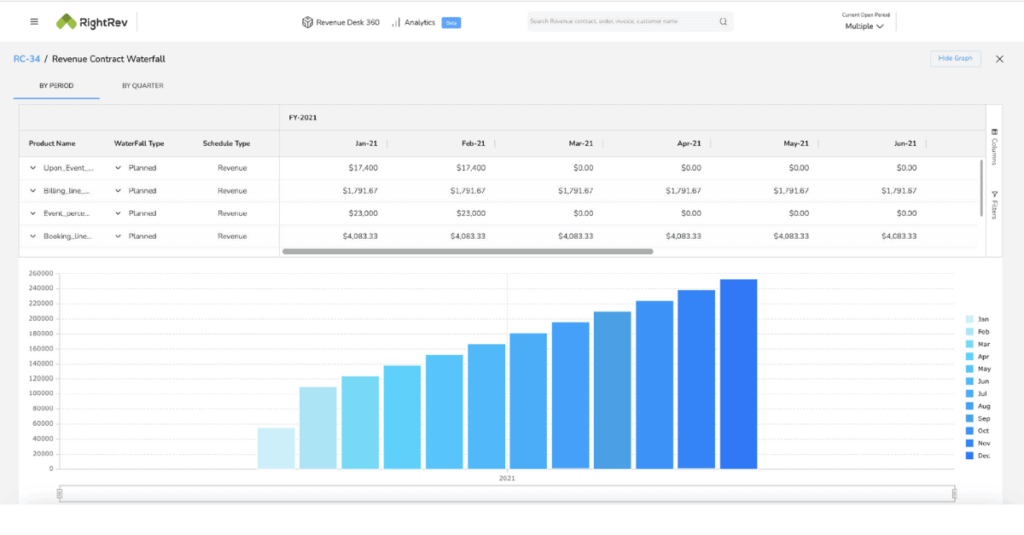ERP (enterprise resource planning) systems have become a standard business technology. ERPs started in the 1960s for Manufacturing companies, before the introduction of multiple element accounting standards, such as, ASC 605 and ASC 606, and SaaS revenue models.1 Their widespread adoption can be attributed to the need to integrate multiple systems and create efficiency and visibility across all of an organization’s, departments, processes, and activities. Today, ERPs are used by organizations of all sizes to manage their financials, operations, product development, and fulfillment. ERP systems have been a staple of the accounting software market for decades, but the rigid structure of most ERP systems forces many companies to find an alternative solution if they want to modernize accounting practices and stay competitive in today’s marketplace.
Today’s enterprises are undergoing massive digital transformation. They are transitioning from a traditional departmental structure to a modern, technology-driven hybrid organization. This also means that the enterprise resource planning system is no longer just a back-end operation but has become an essential part of business operations.
To succeed in this digital era, businesses must implement technologies and processes that enable them to adapt quickly and efficiently to new challenges and opportunities while meeting their unique needs and regulatory requirements. To achieve this, they need a solution that meets today’s stringent IT standards while being future-ready and scalable to meet tomorrow’s revenue demands.
The New Enterprise Landscape and the Need for Flexibility
Over the years, ERPs have built and acquired extensions that aim to offer a complete platform, including revenue management, but these ancillary offerings typically have basic functionality that doesn’t match the needs of today’s customers that have complex use cases. Businesses should think about their needs, their complexity, the future of the company and how the business model may change and adapt to market demands, and which technologies will help them achieve their vision.
Hear a snippet from our Dreamforce session “Beyond the ERP Mirage: Realizing True Business Agility and Revenue Visibility” on how the landscape of the ERP is evolving for Quote-to-Cash teams.
Businesses constantly adapt to changing market conditions and new customer demands. Therefore, their business processes need to be flexible and configurable. The traditional ERP’s design, limits the flexibility that businesses need to pivot, and this is often due to the cost of building and maintaining customizations. For example, if a business introduces a recurring revenue model, such as subscription, consumption, or evergreen, the capabilities of the ERP may support these revenue models but not have flexible configuration to address complex use cases for each of these. To accomplish this, businesses seek manual workarounds to retrofit their data into the ERP’s functionalities. Data transformation and customization are needed to match the ERP’s expectations which is costly, difficult to scale, and requires additional IT resources to build and maintain custom scripts. This is why businesses are re-evaluating their ERPs; they’re not flexible enough to expand to the breadth of all possibilities that can drive revenue complexity. Solutions like RightRev were designed to fit the ERP ecosystem as a revenue sub-ledger, provide the flexibility to configure rules to meet use cases without customization, and communicate with applications within the ERP ecosystem.
A key consideration when evaluating solutions should be the level of effort to implement and the associated costs. While the revenue management extension may be inexpensive, because of the heavy customizations your organization will likely require, the implementation process and maintenance efforts can be a considerable undertaking for Enterprises.
Contrarily, RightRev is designed for flexibility to be accomplished using clicks, not code for implementations and self-serve capabilities with audit trails. Built with an API-first model, RightRev can easily ingest data from upstream sources, enabling flexible revenue recognition automation based on pre, user-defined rules. Thus, eliminating the need for heavy customization and data transformation layers and reducing the need for custom scripting. Users can define revenue recognition rules based on bookings, billings, or user-defined events and distribute based on point-in-time or over-time.
Rising Complexity in Revenue Recognition for Recurring Revenue Models and Contract Changes
ERP revenue automation solutions attempt to solve recurring revenue models but fall short when complex deal structures are introduced and when there is a need to define external revenue triggers, such as percentage of completion, milestones, or consumption, without manual intervention and custom scripts. Meeting these requirements often requires additional customization.
The revenue management solution is not designed to handle modern selling models like ramp discounts and bundles or the need to accommodate contract changes frequently seen with subscription businesses for upgrades, downgrades, or cancellations.
ERP order management functions cannot automatically aggregate or group amendments or new contract changes for businesses that require contract modifications.
Because of the revenue relationship to billed transactions, credit memos are introduced to back out the original agreement and rebook with the added quantities and products. This creates a series of additional steps that require billing corrections to contract changes. Contract modifications to automatically reallocate revenue contracts requires manual intervention to merge revenue arrangements.
Revenue waterfalls also prove challenging in an ERP due to the systematic relationship to billed transactions and the lack of flexibility to map contract changes with revenue policy requirements.

Without consistent and accurate reporting of the changes in recurring revenue metrics, businesses lack insight into what operational and financial issues may exist. Recurring revenue waterfalls are critical to provide visibility for forecasting. Today’s businesses need to rely on technology that enables them to have revenue insights that provide valuable and actionable data to management. This helps leadership to take the required steps to reduce audit risk and optimize Lead-to-Revenue operations.
Adoption of Consumption Business Models
The rise of consumption-based business model adoption has been closely linked to the global shift towards a value-based economy. This shift has led to an increased focus on customer demands. We’ve learned from the subscription economy that end users want the flexibility to change their minds. The consumption model is more attractive for customers because they can throttle up/down however they want and only pay for what they use.
According to The 2021 State of Usage-based Pricing Report from OpenView,2 “45% of SaaS companies say they have usage-based pricing, up from 34% last year.” Having front-office and back-office systems that are flexible enough to adapt to changing business needs is essential to stay competitive. Make sure your applications allow your business to adopt new revenue models as needed and offer the flexibility to support those models now and in the future as needs shift.
ERPs weren’t intentionally built to track consumption-based models, for example, by tier, volume, and pay-as-you-go. Additional complexity includes fixed pricing, minimums/maximums, use it or lose it; all models that require a lot of flexibility on the order management side to price and order. Billing in arrears for consumption models is another common challenge that impacts operations and reporting. These challenges drive organizations to resort to manual workarounds and manual aggregation of data for revenue recognition, which is often tracked offline and limits visibility to key stakeholders.
RightRev accommodates consumption or usage-based requirements for ASC 606 and IFRS 15. It starts with automating a revenue contract’s creation and accounting treatment based on business-defined criteria for all consumption models. The capability extends to accruing revenue based on a future-dated invoice. With RightRev, you can also track multiple performance obligations under one contract and recognize revenue accordingly.
Because of RightRev’s ability to ingest a zero-dollar transaction on day one, users can accommodate models based on tiered pricing, volume, fixed fee, pay-as-you-go, or a combination of these.
A Hyper-Scale Solution to Modernize Revenue Management
RightRev was built to fully comply with ASC 606 and IFRS 15 standards for all business models- subscription, consumption, and one-time. It sets the gold standard for revenue recognition software by providing a flexible, highly scalable platform easily configurable using clicks, not code.
Seamlessly combining upstream data with revenue data allows you to define revenue policies in a connected and centralized system. This saves time and enables operational efficiency to report in real time, manage fewer applications, and close the books faster. Because RightRev was purpose-built to alleviate the pains of legacy revenue automation solutions, it effectively removes the need for costly data transformation measures, ensuring more accurate data and less manual intervention. Thus, customers can close the books faster and with accuracy because of the automation and controls provided by RightRev.
RightRev decouples the distribution and revenue recognition methodology from billing models while still being able to reference billed and/or un-billed transactions for journal entries, accounting, and reporting. RightRev serves as a revenue sub-ledger that enables flexibility and supports complexity to complement an ERPs accounting and general ledger capabilities.
Contact sales for a demo of RightRev.
Sources:
1The History of ERP, 2020, Ian McCue, Sr. Associate Content Manager, Oracle NetSuite
2The 2021 State of Usage-Based Pricing Report, 2021, Kyle Poyar, Partner at OpenView




